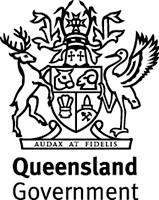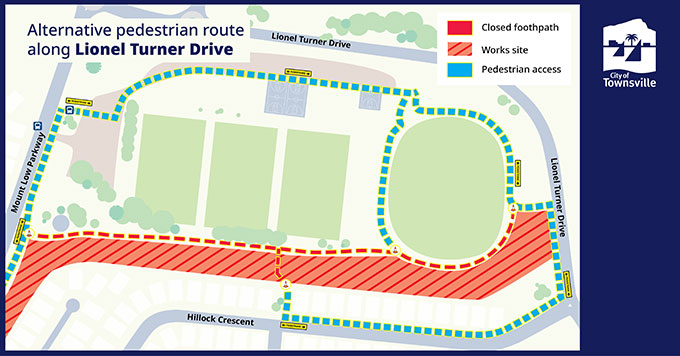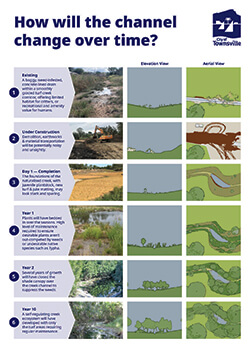Bushland Beach Channel Naturalisation
| Investment | $2.8 million |
|---|---|
| Goal | 4.4 World class liveability through excellent open spaces which promote, protect, and encourage utilisation of our natural environment and heritage. |
| Strategic Purpose | To transform the Bushland Beach channel into a living waterway that enhances the aesthetic of the area and benefits both the community and the natural environment. |
| Status | Underway |
Project Overview
Council is undertaking works to transform the Bushland Beach channel into a living waterway that benefits both the community and the natural environment, following residents’ concerns over the existing open drain adjacent to Peggy Banfield Park.
At beginning of the design process, residents were consulted on the project and outcomes. The design provides for a natural self-regulating ecosystem within the channel through the installation of ponds and a meandering rocky creek bed, integration with existing stormwater pipe inlets and provision for access to maintenance and clean-out.
The project is intended to improve the quality of the water in the Bohle River where it flows to the Great Barrier Reef lagoon of Halifax Bay.
The treed environment of this reshaped drain will demonstrate a new city-wide benchmark on how to reduce the amount of long-term maintenance required to our waterways and provide numerous environmental benefits for wildlife and people, including:
- improved biodiversity with native vegetation that shades out unwanted plants and weeds over time
- natural mosquito control through the provision of a habitat for mosquito predators
- soil amelioration, which will reduce erosion, aid water penetration, promote plant growth and improved soil quality to support native vegetation and trees which will in turn stabilise the banks
- increased cross-sectional capacity of the channel, which will slow flood waters and slightly decrease water levels
- enhanced aesthetic for people and passive recreation - a channel that is reimagined as a living waterway rather than an urban drain
- improved water quality through natural filtering systems and the inclusion of accessible ponds designed for easy maintenance.
Waterway Design
The naturalised waterway has been designed and built to filter sediment, nutrients and pollutants from the water flowing from upstream streets, houses, parks and lawns, which will improve the health of water entering the Bohle River, our valuable downstream coastal environments, and the Great Barrier Reef.
Careful thought has gone into designing the project to allow for high rainfall and reduce flooding events including consideration for the surrounding stormwater features; backed up with rigorous modelling and calculations.
This living, breathing waterway is not a manicured garden bed, but a dynamic system that will change in appearance over 2 to 10 years. 97,000 plants of 75 different local native species have been sourced, grown and planted utilising local businesses and contractors, including First Nations businesses and crews. The carefully selected local native trees, shrubs, grasses, and sedges will continue to grow, spread, drop leaves, and shade-out weeds overtime.
Townsville is home to poorly structured and erosive sodic soils. Council has restored and created healthy soils on this site by using biologically living mulch and dense vegetation establishment. As the plants self-establish over time, some of these species will help stabilise and build healthy soils.
This is project has a broader significance to the entire city of Townsville – and was chosen to demonstrate and innovate solutions which can be replicated into the future for other urban drain corridors, across the city.
Stage 1 (Design) of the project leveraged funding received from the Queensland Government as part of the Cleaner Wastewater Initiative project under the Queensland Reef Water Quality Program.
Project Schedule
Works commenced: Wednesday 24 May 2023
Project completion: November 2024*
* The project completion date has been extended due to unforeseen weather events, resourcing and plant availability..
The works involve:
- removal of two pedestrian bridges with pedestrian detour in place.
- closure of the section of footpath adjacent to the open drain for the duration of the works
- site office and laydown area located in the unused AFL field
- heavy machinery and associated noise and dust to surrounding areas.
Project Status Update - August 2024
Earthworks
- 80% of earthworks were completed before Christmas 2023.
- Remaining earthworks to be completed by August 2024.
Planting
- 60% of planting has been completed with another 20% on hold until minor damage sustained from TC Kirrily is rectified and earthworks recommence.
- 80% of planting completed by mid-April 2024.
- The final 20% of planting will be undertaken in October, to be finished by mid-November.
Project Factsheet
Works Notifications
- Bushland Beach Naturalisation Channel Works - 7 June 2024 (PDF, 289.6 KB)
- Bushland Beach Naturalisation Channel Works - 24 May 2023 (PDF, 2.2 MB)
Frequently Asked Questions
What is the project scope?
Naturalisation is the process of converting drainage channels into ecologically stable and more natural waterways. The project will cover approximately 700 metres of drain running between Mount Low Parkway and Lionel Turner Drive and involves the removal of the existing concrete drain to allow for earthworks, pond construction, ‘living soil’ treatment, new native plantings, and other elements of the waterway design.
Why is the project needed?
The treed environment of this reshaped drain will reduce the amount of long-term maintenance, demonstrate a model for future waterway naturalisation in other places, and provide numerous benefits for wildlife and people, including:
- improved biodiversity with native vegetation that shades out and suppresses unwanted plants and weeds over time
- natural mosquito control through the provision of a habitat for mosquito predators
- soil amelioration, which will reduce erosion, aid water penetration, promote plant growth and improve poor soil structure and quality to support native vegetation and trees, which will in turn stabilise the banks
- increased cross-sectional capacity of the channel, which will slow flood waters and slightly decrease water levels
- enhanced aesthetic for people and passive recreation - a channel that is reimagined as a living waterway rather than an urban drain
- improved water quality through natural filtering systems and the inclusion of accessible ponds designed for maintenance.
What is the project timeframe?
Works commenced: Wednesday 24 May 2023
Project completion: November 2024*
| Stage | Date |
|---|---|
| Preliminary works | May 2023 |
| Earthworks | June 2023 – August 2024* |
| Revegetation | November 2023 – mid-November 2024* |
* The project completion date has been extended due to unforeseen weather events, resourcing and plant availability.
How will I be impacted?
Impacts during the construction works (May – December 2023) include:
- removal of two pedestrian bridges with pedestrian detour in place.
- closure of the section of footpath adjacent to the open drain for the duration of the works
- site office and laydown area located in the unused AFL field
- heavy machinery and associated noise and dust to surrounding areas.
After construction works are completed, the waterway will continue evolving overtime. Maintenance is a key priority for Council, especially in the first 1-2 years of the project’s delivery – ensuring problematic weeds do not out-compete the planted native trees/shrubs/sedges. Council officers will be completing regular inspections to assess and deliver maintenance as required to ensure the asset is functioning as intended.
How will the community benefit?
Naturalising the drain at Bushland Beach will improve flood management by slowing flood waters, increasing infiltration in soils and ponds, and decreasing water levels, improve the quality of water entering the Bohle River, enhance biodiversity, provide for natural mosquito control and reduce erosion.
How much will it cost?
Townsville City Council has invested $2.8 million into the construction of the project.
The project design was funded by the Wastewater Stewardship Strategic Assessment Stage 2 Project (Cleaner Wastewater) provided by the Queensland Department of Environment, Science and Innovation. A grant for $455,000 was received and used for various wastewater projects, including approximately $125,000 to fund design and preliminary aspects of this project, including:
- Developing Bohle River Catchment Offset Roadmap (source modelling, catchment assessments, identify sites and treatment options, economic assessments, risk matrix)
- Detailed design of identified assets or solutions
- Relevant permits for construction and establishment works approvals.
- Asset management and maintenance plans developed
- Education packaged developed and disseminated
How will the channel change over time?
This living, breathing waterway is not a manicured garden bed, but a dynamic system that will change in appearance over time. The carefully selected local native trees, shrubs, grasses and sedges will continue to grow, spread, shade-out and drop leaves.
Maintenance is a key priority for Council, especially in the first 1-2 years of the project’s delivery – ensuring problematic weeds do not out-compete the planted native trees/shrubs/sedges. Many species will also self-establish over time; some of these species can serve a purpose to stabilise and build healthy soils.
After construction works are completed, the appearance of the site will continue evolving overtime:
- Revegetation stage (November 2023 – August 2024) - Planting of over 75 different species of plants. Upon completion of earthworks, the site will appear stark and neat as vegetation hasn’t started growing and planting density not yet achieved.
- Vegetation establishment stage (November 2023 – August 2024) – Coinciding with the wet season, this stage sees the rapid growth of the juvenile plants, which is necessary for the stabilisation of the site and requires ongoing maintenance to ensure the planted vegetation is not taken over by weeds or other undesirable species.
- Year 1 – Plants will have established themselves, though some maintenance is still required to ensure non-beneficial weeds and undesirable species do not take over.
- Year 2 – As plants grow over the years, a shade canopy will develop over the channel, sedges and appropriate native grasses will remain and help to suppress weed growth in lower and instream areas.
- Year 10 – A self-regulating creek ecosystem will have developed with only the turf areas requiring regular maintenance.
 Stage 1 (Design) of this project was proudly funded by the Queensland Government’s Queensland Reef Water Quality Program in association with Townsville City Council.
Stage 1 (Design) of this project was proudly funded by the Queensland Government’s Queensland Reef Water Quality Program in association with Townsville City Council.







